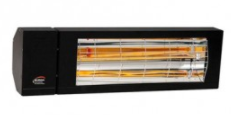 If you have a look at our outdoor heaters then you will notice that all our products have what is known as an IP rating. IP, or International Protection markings, classify the level of protection an appliance has against solid particles and water. The aim of the rating is to give buyers a much clearer understanding of how waterproof or dustproof a product is. Often sites can give vague descriptions of how waterproof their product actually is, which could lead to the customer exposing the heater to a place or situation where it could be damaged. While the rating system is not complicated, it is often something that buyers have not come across before, and can be confusing.
If you have a look at our outdoor heaters then you will notice that all our products have what is known as an IP rating. IP, or International Protection markings, classify the level of protection an appliance has against solid particles and water. The aim of the rating is to give buyers a much clearer understanding of how waterproof or dustproof a product is. Often sites can give vague descriptions of how waterproof their product actually is, which could lead to the customer exposing the heater to a place or situation where it could be damaged. While the rating system is not complicated, it is often something that buyers have not come across before, and can be confusing.
To help you, we have put together this short explanation of the IP rating system and how it works so you don’t feel lost when looking to buy an outdoor heater.
What the Numbers Mean
IP ratings use an ascending scale to determine how weatherproof a heater is, so 1 is a low rating and 9 is a high rating. You will notice that there are also two numbers: the first digit is the heater’s solid particle protection and the second is its protection against water. So, when a heater has a IP24 rating it means that its solid particle protection is 2 and its water protection is 4.
The rating system is based on accurate measurements of a heater’s ability to block out water and solid particles. The scale for solid particle protection starts at 1 and goes up to 6, whereas the water protection goes up to 9. A breakdown of the classification for protection against solid particles is below:
1- effective against objects no smaller than 50mm in size
2- effective against objects no smaller than 12.5mm in size
3- effective against objects no smaller than 2.5mm in size
4- effective against objects no smaller than 1mm
5- effective against dust but some ingress permitted
6- complete protection against dust
To put these numbers into context, a rating of 2 would prevent fingers and any other small object from getting inside the heater, so even at this lower level of safety, an IP24 heater would be a safe option for a wall mounted installation. However, if you had the heater in reach of small children you may want to consider a higher level of protection to ensure they don’t accidentally touch the hot elements. Below is the breakdown of the classification for protection against liquids:
1- protection against dripping water
2- dripping water when tilted at 15°
3- spraying water at a 60° angle
4- splashing of water
5- low pressure water jets
6- high pressure water jets
7- immersion up to 1m deep
8- immersion up to 3m deep
9- powerful high temperature water jets
If you see a product with a number replaced by X then it has not been rated for that specification, although a lot of people assume that this means it has no protection.
 To give an example of the rating system in action we will use the Burda Term 2000 which has an IP44 rating. This means that it will be protected against objects bigger than 1mm, so for example, most wires and screws, and will be protected against splashing of water so rainfall will pose no issue. A low IP rating doesn’t mean a product is not worth buying, it simply means that these types of heaters are better suited to indoor use. The Burda Smart Infrared Heater has an IP20 rating, but is specifically built for indoor use so the lack of protection from water isn’t an issue for this heater. On the other side of the scale is our highly waterproof version of the Burda Term 2000 which can come with an IP67 rating. This heater could be used in a dusty factory as it is able to keep fine dust particles out, and it is also ideal for outdoor use because of its high water protection rating.
To give an example of the rating system in action we will use the Burda Term 2000 which has an IP44 rating. This means that it will be protected against objects bigger than 1mm, so for example, most wires and screws, and will be protected against splashing of water so rainfall will pose no issue. A low IP rating doesn’t mean a product is not worth buying, it simply means that these types of heaters are better suited to indoor use. The Burda Smart Infrared Heater has an IP20 rating, but is specifically built for indoor use so the lack of protection from water isn’t an issue for this heater. On the other side of the scale is our highly waterproof version of the Burda Term 2000 which can come with an IP67 rating. This heater could be used in a dusty factory as it is able to keep fine dust particles out, and it is also ideal for outdoor use because of its high water protection rating.
Hopefully this guide has cleared up any confusion you may have had over IP ratings and you are now ready to search for the perfect outdoor heater on our website.
